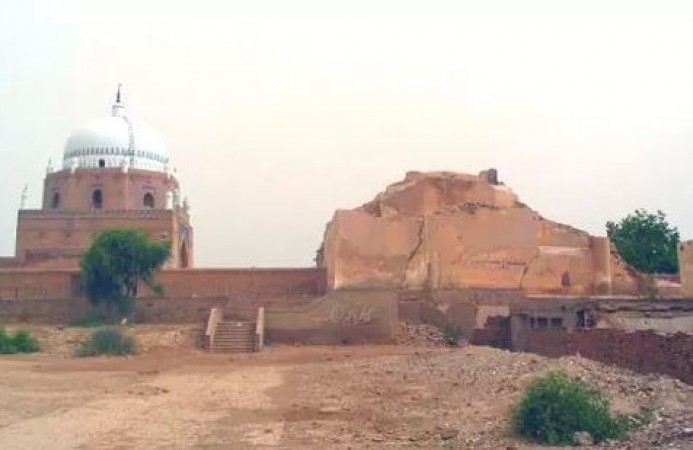
The Multan Sun Temple, also known as the Aditya Sun Temple, stands as a remarkable testament to the rich historical and cultural heritage of Pakistan. Located in the city of Multan, in the province of Punjab, this ancient temple once graced the landscape with its architectural brilliance and religious significance. Unfortunately, over the centuries, the temple has suffered from the ravages of time and the changing political and social dynamics of the region. Today, it remains a forgotten marvel, obscured by the sands of time, but its historical importance and architectural grandeur continue to intrigue archaeologists and historians alike.
Also Read: Cambodia: A Land of Ancient Splendor and Resilience
The Multan Sun Temple dates back to ancient times, with its origins shrouded in the mists of history. The region surrounding Multan has been a crucible of diverse civilizations, each leaving behind their unique imprint on the temple and the surrounding landscape. Some historians believe that the temple was constructed during the rule of the Hindu Shahi dynasty in the 9th or 10th century, while others suggest it may have been built even earlier, during the era of the Mauryan Empire.
The Multan Sun Temple's architectural design represents an amalgamation of Hindu and local influences. The temple was dedicated to the Sun God, Surya, and was envisioned as a stunning example of ancient temple architecture. Comprising multiple structures, the temple complex boasted intricate carvings, exquisite sculptures, and ornate pillars, all of which reflected the artistic prowess of the craftsmen of that era.
The primary temple structure often referred to as the sanctum sanctorum or garbhagriha, housed the main deity, a captivating idol of Surya, typically depicted with his chariot and seven horses. The idol was positioned to capture the first rays of the rising sun, creating a mesmerizing spectacle during the early hours of the day.
Also Read: Udupi Sri Krishna Matha: A Journey through Time and Spirituality
The temple served as a spiritual center, hosting religious ceremonies, festivals, and various rituals dedicated to the Sun God. Pilgrims would flock to the temple to seek blessings, offer prayers, and partake in festivities, imbuing the site with a sense of devotion and sanctity.
The fate of the Multan Sun Temple took a tragic turn during the medieval period when the region witnessed a series of invasions and conquests. The temple faced the brunt of these conflicts, as several invaders viewed it as a symbol of pagan worship. The Arab and Turkic invasions of the 8th and 9th centuries resulted in significant damage to the temple, with parts of it being ransacked and defaced.
As the political landscape changed, the temple faced further neglect and decay during subsequent centuries. The once-thriving temple complex fell into desolation, and its religious significance gradually faded away. The rise of Islam in the region further marginalized the temple, and it ceased to be the vibrant spiritual hub it once was.
Also Read: Kotoku-In Temple: A Serene Sanctuary of Peace in Japan
In more recent times, the Multan Sun Temple has drawn the attention of archaeologists, historians, and preservationists seeking to uncover its secrets and restore its former glory. Excavations and studies have shed light on the temple's historical significance and architectural splendor. However, restoration efforts have proven to be challenging due to limited resources, bureaucratic obstacles, and the fragile state of the temple's remaining structures.
Various initiatives by the Pakistani government and heritage organizations aim to safeguard the temple and promote its historical value. They strive to preserve this cultural heritage for future generations, underscoring the importance of recognizing and protecting the nation's diverse historical legacy.
The Multan Sun Temple holds immense tourism potential. As more people become aware of its historical significance and architectural brilliance, the temple could become a major tourist attraction, drawing visitors from around the world. Enhancing the accessibility and infrastructure around the site could promote cultural tourism and boost the local economy.
Also Read: Kinkaku-ji Temple: A Glorious Jewel of Japan's Golden History
The Multan Sun Temple, a remarkable feat of ancient architecture and religious significance, stands as a testament to Pakistan's rich historical heritage. Though its grandeur has been marred by the passage of time and neglect, the temple continues to intrigue and captivate those who seek to understand the past. As preservation efforts continue, there remains hope that this forgotten marvel will rise again, allowing future generations to appreciate and cherish the legacy of their ancestors. The Multan Sun Temple serves as a reminder of the importance of preserving our cultural heritage and honoring the footsteps of our forebears.
Also Read: White Horse Temple: A Historical and Cultural Icon of China